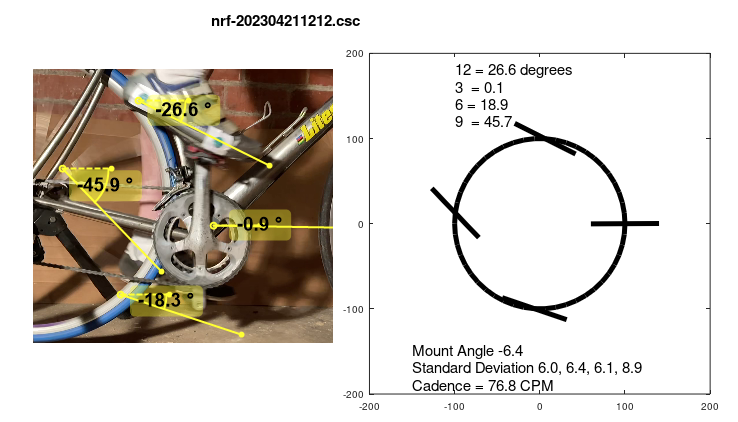Q: How accurate is this thing?
I should not be posting anything about my work unless I can show that it actually works. Over the years I have tested with a mechanical simulator and video recordings with optical position sensors. I have looked for, and asked about existing commercial tools. Lately I am considering a mechanical test sensor, but this will take considerable time to design, build and test. For now I decided to try what appear to be some recent video analysis tools. Kinovea is a video annotation tool designed for sport analysis.
I have my 22 year-old Litespeed Ultimate sitting on a trainer, with a flood light and iPhone 2020 SE pointed at the crank arm. I wrapped white tape at either end of my shoe and colored a black dot on each. I was able to capture a sequence of 20 pedal strokes at 60 fps. (My attempts at slo-mo recording ran afoul of simply copying the data off my iPhone. Yes, I even tried the Quicktime export trick.)
None of the Kinovea examples I saw included tracking angles where there wasn’t at least one stable point of reference. In my case both points of my shoe move throughout the video frame and confused the program’s tracking. What I show next is a single pedal stroke measured by Kinovea, along-side my sensor summary of all 20 pedal strokes.
Pictured here are the Kinovea 9 o’clock and 3 o’clock positions (LH and RH), along with my summary diagram.
Kinovea Sensor
LH -45.5 43.9
RH 6.7 -7.3
The polarity is opposite due to the difference in how the tools represent angle orientation, but the numbers are close. Another way to compare is direct waveforms:
Again, this is a comparison between one pedal stroke by Kinovea and the 20 pedal average of my sensor. This comparison is consistent with my years of testing. I will need to build that mechanical testing tool if anyone is ever interested in picking up and using this technology. –Bryan

Comments
Post a Comment